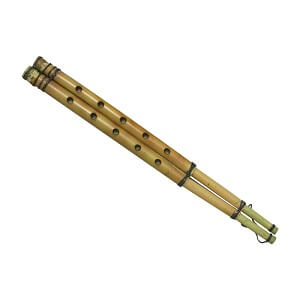Double Clarinet
 Double clarinet with cylindrical bore. Two cane pipes of unequal length. The shorter pipe has 5 finger-holes and is the chanter; the long pipe has no finger holes and is the drone pipe. Pipes bound together with cotton thread. Each pipe has its own up-cut idioglottal reed also made of cane.
Double clarinet with cylindrical bore. Two cane pipes of unequal length. The shorter pipe has 5 finger-holes and is the chanter; the long pipe has no finger holes and is the drone pipe. Pipes bound together with cotton thread. Each pipe has its own up-cut idioglottal reed also made of cane.
The sound of these instruments have been heard throughout Egypt for thousands of years and some scholars believe they are an early ancestor of the bagpipes. Today the arghūl and zummāra are mainly played by Nile boatmen, shepherds, and folk musicians. They are often played at weddings and dances where they are used to accompany folksongs.
Clarinets in sizes other than B♭ and its sharp-key equivalent in A include the C clarinet, much used in the Classical period and often preserved in German orchestration; octave clarinets in A♭, used in large European bands; and sopranino clarinets in F and later E♭, the latter often used with its sharp-key equivalent in D (popular in earlier days). Alto (or tenor) clarinets that followed the late 18th-century clarinette d’amour in A♭, G, or F and the more successful basset horn in F include the wider-bore alto clarinet in F and later E♭, made with upturned metal bell and a curved metal crook holding the mouthpiece. Bass clarinets in B♭ were at first built experimentally but after 1810 were built in many designs. The modern version, with twice-curved crook, was influenced by the 1838 design of the Belgian instrument-maker Adolphe Sax, to which the upturned bell was later added. Contrabass clarinets are made in E♭ or in B♭.